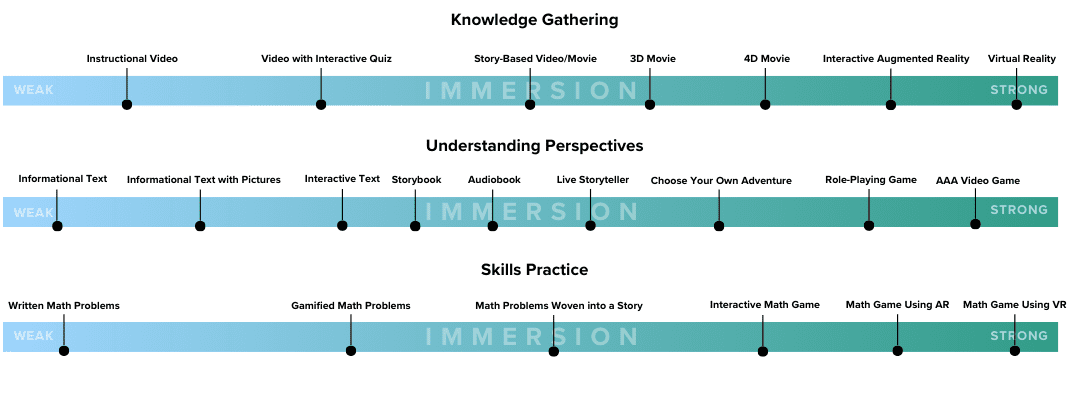In today’s classrooms, creating immersive learning experiences is more than just a trend—it’s a powerful tool for engaging students in a way that amplifies understanding and retention. But what makes an experience truly immersive, and why does it matter? Below, we’ll outline five key principles to help educators evaluate how immersive an experience is for their students and the lasting impact it can have on learning.
The Learning Amplifier – Why Immersive?
It’s often assumed that immersive experiences—and especially those which involve shiny tech—are beneficial only to students’ interest levels. But it’s not true; engagement is just the starting point in any learning environment. While keeping students engaged is essential, turning that engagement into a deep investment in learning leads to much greater outcomes. Immersive experiences take students beyond surface-level interaction and encourage them to fully absorb and connect with the material.
When students feel immersed in an experience, they are more receptive to the content, which enhances retention, fosters deeper understanding, and creates a lasting connection with the subject. Immersion can also accelerate learning, allowing students to grasp complex concepts more quickly. This is why, at Discovery Education, we call immersion ‘the learning amplifier’.
“We're amplifying their depth of understanding, we're amplifying the speed of understanding, we're amplifying the quality of the learning, and we're amplifying the quality of what comes back."
Phil Birchinall, DE Senior Director of Immersive Content
"How Immersive Is It?"
Immersion is subjective—what captivates one student may not have the same effect on another. While some students are drawn in by an engaging story, others may thrive on competition or sensory stimulation. To help assess where a learning tool or experience falls on the “immersive scale,” and to help elevate an activity in small ways, educators can ask themselves these guiding questions:
1. Stimulation: How Many Senses Are Engaged?
One of the key components of immersion is sensory engagement. The more senses an experience stimulates, the more likely it is to immerse the student. No matter what you want your students to immerse themselves in, there is always more you can do to appeal to their senses. Here are a few ways to enhance sensory stimulation:
- Audio: Thoughtful use of voiceovers, music, and sound effects can transform an experience.
- Movement in Real Space: Pairing visual content with physical movement, such as walking or using life-sized augmented reality (AR), greatly enhances immersion.
- Affect the Air: Introduce a scent; create a cold breeze; turn up the heat.
- Virtual Reality (VR): Fully immersive environments where students can interact with the content in 360 degrees can have a profound effect.
2. Gamification: How Compelling Is the Experience?
Gamification taps into students’ natural desires for competition and achievement. Educators can ask themselves “Does this experience make students want to keep going?” Some elements that make gamification effective include:
Scoring and Timing: Rewarding students with points or time-based goals can maintain engagement and encourage repeat participation.
Progression: Experiences that involve skill development and level progression keep students motivated to return and continue learning.
Content Integration: Tie learning objectives to game progress so that students are motivated to consume educational content as they advance.
3. Narrative: Is There a Strong Storyline?
Learning which stems from a well-told story is remembered more accurately, and for far longer, than learning derived from facts and figures. A strong narrative can anchor students in an experience, making it more memorable and meaningful. Ask:
- Does the experience have events or a storyline that students can follow?
- Are these events instructional, entertaining, or both?
- Is the story relatable and exciting enough to engage students emotionally?
A well-told, relatable story not only grabs students’ attention but also fosters a deeper connection to the learning material.
4. Production Quality: How Believable Is the Environment?
A crucial aspect of immersion is the realism of the environment in which students learn. If the surroundings are believable and match the expectations of students, they are more likely to stay immersed. Consider:
- How realistic is the design of the environment? Does it move or appear interactive?
- Is the environment explorable, or are there restrictions? In a fully immersive experience, students should feel they can explore freely, without bumping into limitations that break the immersion.
5. Student Agency: How Much Control Do Students Have?
Agency—how much control students have over their learning experience—is a key factor in immersion. The more control students have, the more likely they are to feel engaged. Educators should ask:
- Physical Agency: Can students move around the space freely, or are they on a predetermined path?
- Interaction: Can students manipulate objects or their surroundings?
- Decision-Making: Do students have the power to make choices that impact outcomes? Are there opportunities for students to interact with elements that may not directly affect the learning objective but enhance the overall experience?
Climbing the Immersive Scale
Immersive learning environments go beyond traditional classroom engagement, tapping into students’ emotions, senses, and personal interests. By climbing the immersive scale—whether through sensory stimulation, gamification, storytelling, or student agency—educators can create experiences that transform passive learning into active, deeply rooted knowledge.
Consider the ways in which these example activities can be made to climb the scale and amplify learning: knowledge gathering in Geography, understanding perspectives in History, and repetitive skills practice in Math. Do you agree with placement of the following exercises on the immersive scale?

Incorporating these five principles into educational tools and strategies can significantly impact student learning outcomes, making the content more memorable, enjoyable, and effective. There’s no need to try and nail them all at once, but the next time you consider a learning product or experience for your classroom, ask yourself: how immersive is this, and how can I drive it up the scale and make it even more so?






